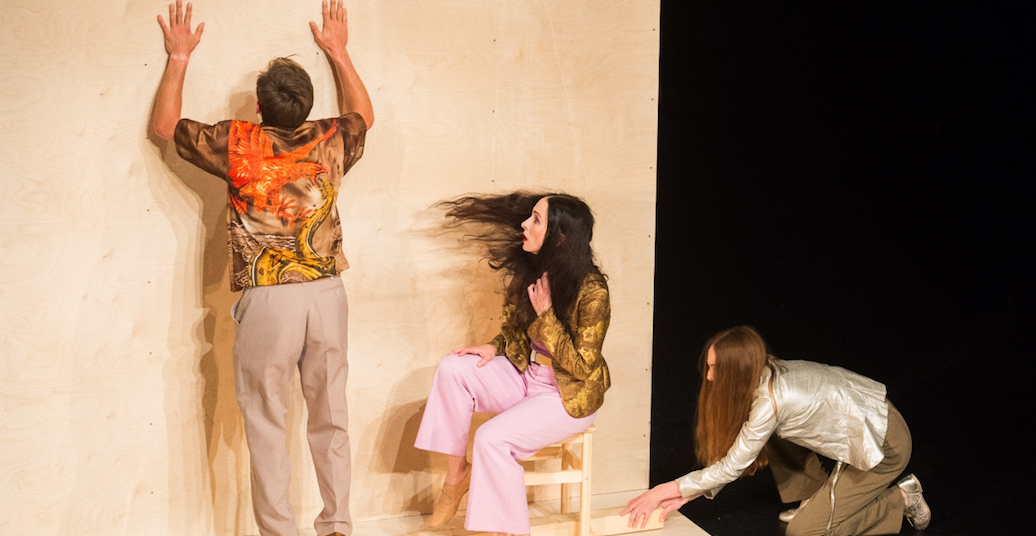With “The Emergency Artist”, Clément Layes provides space for the openness of meaning in language and action. In times of increasing political isolation, it can be interpreted as a kind of artistic protest.
In “The Eternal Return”, his first group piece, Clément Layes broached the issue of life in the style of Friedrich Nietzsche, as an eternal recurrence. He transposed the mundane gray of his routine actions into a spartan one-room stage construction, which was inspired by the short film “Tango” by Polish director Zbigniew. Portrayed with subtle humor, the will to resist every form of monotonous recurrence as well as the threat of mental and physical paralysis is discernible: with the repetition of short, personalized, and at the same time accumulating and overlapping choreographed storylines, sixteen performers extract lightness from the ever sameness. In this machinery, indicative of a hamster wheel, new constellations of relationships and meaning continuously arise, and with them loopholes for artistic freedom driven by an invisible engine otherwise known as improvisational talent & creativity.
Clément Layes is looking for holes in a system dominated by efficiency. The same goes for his most recent group choreography entitled “The Emergency Artist”. This time routine is not conceived of as bleak regularity, but rather as the daily and matter of course overexertion of oneself in the style of our present zeitgeist. The intensity and unmanageability of possibilities, which characterize our world today and were already touched upon in “The Eternal Return”, initially resonate in the life-driven protagonist of the piece.
“Attention!”: a falling wood wall turns out to be a tiltable wooden stage with a floor and a back wall on which the aforementioned main actor dangles as if from a cliff – helpless and panicked although his cool outfit is more reminiscent of “The Fall Guy”. Far less agitated, two female figures with large bowler hats, sunglasses, and long hair enter: two assistants, who actively lend their support. This happens, for example, when they bridge the half meter distance between him and the imaginary abyss with a small stool. And also when they demonstrate to him with devilishly angelic tips —“Run for your life” – “I would choose not to”— on the only seemingly risky beam-on-stool-scale construction that his behavior of wanting to give his all every day is compulsive and his fear of failure (“I can” and “I can not”) is unfounded. His center of gravity is on the middle of the beam and on the stool. Even if both performers were to slowly move away from his right and left sides, nothing would happen to him.
Above all, it is Clément Layes’ ingenious play with the relationship between language, thought, and action that is so inspiring this evening and embodies a successful artistic development following “The Eternal Return”. It reinforces an attitude towards life that advocates a tolerance for ambiguity. This is shown by, among other things, the video installation that accompanies the piece in front of the Sophiensæle Festsaal. In it, Layes correlates notions from the student revolts in 1968 in an associative reference to the present: “Hurry” … “or” … “it will be” … “never or now”. Or: “We don’t care” … “About borders”. Anyone declaring the former prompt to an emergency state, “now or never”, as their daily life credo, will sooner or later exceed their mental, physical, and spiritual limits and inevitably run out of breath – that is one way to understand Layes here. Coupled with rising societal deterioration, according to the author’s addendum, the need for clear (linguistic) relationships is probably not far beyond – “Well, guess what.”
In the second half of the stage performance, the same performers appear and execute the same actions in a larger group. Especially memorable is one scene that was accompanied by the words “just smile”. In its original form, it has the effect of a biting commentary on a competition-oriented consumption society. Repeated, the image laid out is of a tolerant-relaxed coexistence of diverse individuals, who do not rely on polarization but rather on the beams they sit, stand, or even hang from upside down to maintain balance together – an authentic experienced “just smile” that can’t be balanced out with money.
Even though Layes’ second group piece is performatively less persuasive than its predecessor, and occasionally too prosaic, a complex artistic approach is apparent, one which I consider to be absolutely imperative in its socio-political and educational dimension. “The Emergency Artist“ leaves a social emergency exit available that is not only one-directional: art. While also addressing the art to confront life’s contradictions with self-determination rather than lapsing in a panic into blind activism.
English Translation by Melissa Maldonado




